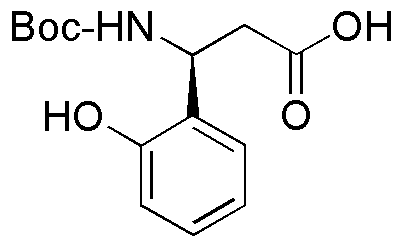Boc-(S)-3-amino-3-(2-hydroxyphenyl)propionic acid is widely utilized in research focused on:
- Pharmaceutical Development: This compound serves as a building block in the synthesis of various pharmaceuticals, particularly in designing drugs that target specific biological pathways. Its unique structure allows for modifications that enhance drug efficacy.
- Peptide Synthesis: It is commonly used in solid-phase peptide synthesis, where its protective Boc group facilitates the assembly of complex peptides while preventing unwanted reactions, ensuring high purity and yield.
- Biochemical Research: Researchers employ this compound in studies related to enzyme activity and protein interactions, helping to elucidate mechanisms of action in biological systems.
- Material Science: The compound can be incorporated into polymer matrices to create materials with specific properties, such as improved biocompatibility for medical devices or drug delivery systems.
- Analytical Chemistry: It is utilized as a standard in chromatographic techniques, aiding in the quantification and analysis of related compounds in various samples, ensuring accuracy and reliability in research findings.
General Information
Properties
Safety and Regulations
Applications
Boc-(S)-3-amino-3-(2-hydroxyphenyl)propionic acid is widely utilized in research focused on:
- Pharmaceutical Development: This compound serves as a building block in the synthesis of various pharmaceuticals, particularly in designing drugs that target specific biological pathways. Its unique structure allows for modifications that enhance drug efficacy.
- Peptide Synthesis: It is commonly used in solid-phase peptide synthesis, where its protective Boc group facilitates the assembly of complex peptides while preventing unwanted reactions, ensuring high purity and yield.
- Biochemical Research: Researchers employ this compound in studies related to enzyme activity and protein interactions, helping to elucidate mechanisms of action in biological systems.
- Material Science: The compound can be incorporated into polymer matrices to create materials with specific properties, such as improved biocompatibility for medical devices or drug delivery systems.
- Analytical Chemistry: It is utilized as a standard in chromatographic techniques, aiding in the quantification and analysis of related compounds in various samples, ensuring accuracy and reliability in research findings.
Documents
Safety Data Sheets (SDS)
The SDS provides comprehensive safety information on handling, storage, and disposal of the product.
Product Specification (PS)
The PS provides a comprehensive breakdown of the product’s properties, including chemical composition, physical state, purity, and storage requirements. It also details acceptable quality ranges and the product's intended applications.
Certificates of Analysis (COA)
Search for Certificates of Analysis (COA) by entering the products Lot Number. Lot and Batch Numbers can be found on a product’s label following the words ‘Lot’ or ‘Batch’.
*Catalog Number
*Lot Number
Certificates Of Origin (COO)
This COO confirms the country where the product was manufactured, and also details the materials and components used in it and whether it is derived from natural, synthetic, or other specific sources. This certificate may be required for customs, trade, and regulatory compliance.
*Catalog Number
*Lot Number
Safety Data Sheets (SDS)
The SDS provides comprehensive safety information on handling, storage, and disposal of the product.
DownloadProduct Specification (PS)
The PS provides a comprehensive breakdown of the product’s properties, including chemical composition, physical state, purity, and storage requirements. It also details acceptable quality ranges and the product's intended applications.
DownloadCertificates of Analysis (COA)
Search for Certificates of Analysis (COA) by entering the products Lot Number. Lot and Batch Numbers can be found on a product’s label following the words ‘Lot’ or ‘Batch’.
*Catalog Number
*Lot Number
Certificates Of Origin (COO)
This COO confirms the country where the product was manufactured, and also details the materials and components used in it and whether it is derived from natural, synthetic, or other specific sources. This certificate may be required for customs, trade, and regulatory compliance.


